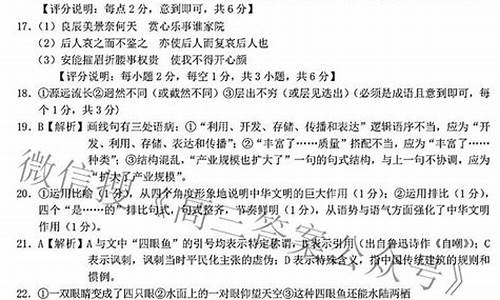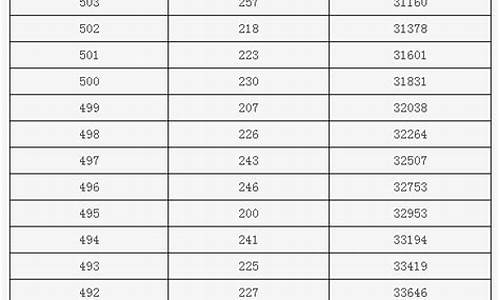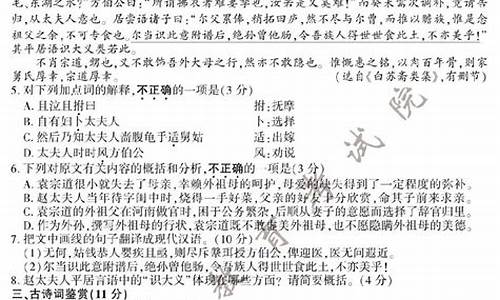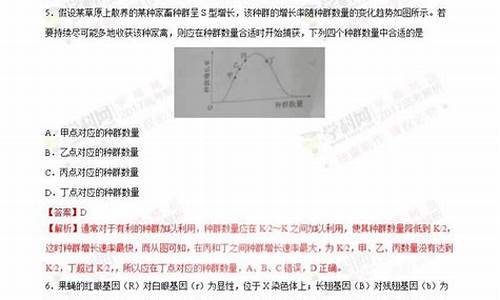您现在的位置是: 首页 > 热门专业 热门专业
动词时态高考真题及答案_高考英语动词时态语态专练
tamoadmin 2024-07-25 人已围观
简介1.高三高考跪求英语时态的总结?2.动词的语态英语基础语法知识点汇总3.有几题英语动词的时态和语态不太懂,请高人指教导读公共英语考试想必大家对此考试一定不陌生吧,如今公共英语的用处非常广泛重要,公务员考试英语免考,自考,成人高考升专科,升本科英语也免考,考试分为笔试和口试,根据我国相关规定,在2020年笔试考试全面实行答题卡模式。公共英语考试也不例外。为了帮助大家都能顺利通过考试,下面是小编为大家
1.高三高考跪求英语时态的总结?
2.动词的语态英语基础语法知识点汇总
3.有几题英语动词的时态和语态不太懂,请高人指教
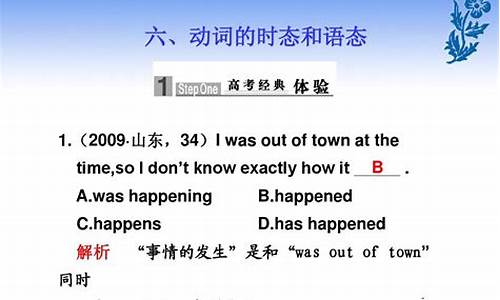
导读公共英语考试想必大家对此考试一定不陌生吧,如今公共英语的用处非常广泛重要,公务员考试英语免考,自考,成人高考升专科,升本科英语也免考,考试分为笔试和口试,根据我国相关规定,在2020年笔试考试全面实行答题卡模式。公共英语考试也不例外。为了帮助大家都能顺利通过考试,下面是小编为大家整理的“公共英语考试语法考点精讲:非谓语动词的时态和语态”相关内容,希望对大家有所帮助。
1. 非谓语动词的时态
不定式或现在分词的动作若发生在谓语动词的动作之前,用完成式(过去分词没有完成式),否则,就用一般式。若与谓语动作同时发生,并强调正在进行的情景或持续性,可用不定式的进行式(现在分词和过去分词均没有进行式)。如:
Hing failed twice, he didn’t want to try again. 他已经失败了两次,不想再试了。
He came in, followed by his secretary. 他走了进来,后面跟着他的秘书。
He seems to he caught a cold. 他似乎感冒了。
He seems to be saying something. 他似乎在说什么。
2.非谓语动词的语态
不定式或-ing 形式与其逻辑主语若是主动关系,用主动式;若是被动关系,用被动式。如:
Who is the woman being operated on? 正在动手术的女人是谁?
Did it need to be done so soon? 这事需要这么快就做吗?
注:(1) 过去分词没有被动式。(2) 有些非谓语动词要主动式表示被动意义。
以上就是小编今天给大家整理发送的关于“公共英语考试语法考点精讲:非谓语动词的时态和语态”的相关内容,希望对大家有所帮助。如果你打算零基础备考公共英语考试,小编建议你先从考试大纲出发备考哦!
高三高考跪求英语时态的总结?
英语时态分为16种:一般现在、一般过去、一般将来、过去将来时,以及这四者的进行时、完成时和完成进行时。
一般过去时 Ved (谓语动词用过去式)
一般将来时 Be going to + V / Will + V
过去将来时 Be的过去时 going to +V/ Would +V
现在进行时 Be +doing
过去进行时 was/were doing/ was /were not doing
将来进行时 Will +be+doing/ will not be doing
现在完成时 he +done/ he not done
过去完成时 Had+done/ had not done
现在完成进行时 he/has been doing/ he has not been doing
过去完成进行时 had been doing/ had not been doing 1. 一般现在时
用法:
A) 表示现在发生的动作、情况、状态和特征。
B) 习惯用语。
C) 经常性、习惯性动作。
例:He always helps others. (他总是帮助别人。)
D) 客观事实和普遍真理。尤其要注意,如果前后文不是一般现在时,则无法保持 主句、从句时态一致。
E) 表示一个按规定、或安排要发生的动作,(仅限于某些表示“来、去、动 、停、开始、结束、继续”等的动词 )可以与表示未来时间的状语搭配使用 。常见的用法是:飞机、火车、轮船、汽车等定期定点运行的交通方式。
例:The next train lees at 3 o'clock this afternoon.
(下一趟火车今天下午3点开车。)
How often does this shuttle bus run? (这班车多久一趟?)
F) 在时间和条件状语从句里经常用一般现在(有时也用现在完成时)表示将来事 情。
例:When you he finished the report, I will he waited for about 3 hours.(等你完成这份报告的时候,我就已经等了将近3个小时了。)
2. 现在进行时(be doing)
用法:现在正在进行的动作。
3. 现在完成时(he done)
用法:
A) 表示动作到现在为止已经完成或刚刚完成。
例:I bought a new house, but I _________ my old one yet, so at the moment I he two houses.
A) didn't sell B) sold C) hen't sold D) would sell
答案是C) hen't sold。
B) 表示从过去某时刻开始,持续到现在的动作或情况,并且有可能会继续延续下去。此时经常用延续性动词。时间状语常用since加一个过去的时间点,或for加一段时间,或by加一个现在时间。
例:Great as Newton was, many of his ideas ___________ today and are being modified by the work of scientists of our time.
A) are to challenge C) he been challenged
B) may be challenged D) are challenging
全句的意思是:“虽然牛顿是个伟大的人物,但他的许多见解直到今天还在受到挑战,并且被现代科学家的工作所修正。”challenge是及物动词,在本句中应当是被动语态;其动作延续到今天,所以要用现在完成时态。可见答案是C) he been challenged。A) are to challenge和D) are challenging都是主动语态,不可能是答案。B) may be challenged虽然是被动语态,但意思与全句内容不合,所以不对。
C) 表示发生在过去,但对现在仍有影响的动作或情况。通常用点动词,如:arrive, begin, find, give, lose等。
例:John has broken his left leg.(约翰摔断了左腿。)
注意事项
A) 现在完成时是联系过去和现在的纽带。现在完成时和过去时的区别在于:现在完成时强调动作的动态,或受动态的影响,是动态的结果,对现在有影响;过去时只表示过去的某个具体时间里发生的动作,与现在没有联系。
例:He worked in that hospital for 8 years.(他曾经在那家医院工作了8年。这只是讲述一个过去的事实,他现在已经不在那家医院了。)
He has worked in that hospital for 8 years.(他已经在那家医院里工作了8年。表示他从过去开始工作,一直工作到现在,现在仍在那家医院工作。)
B) 因为含有for加一段时间或since加一个时间点这样的时间状语的完成时,有动态和延续性的特点,所以不能使用终端动词或瞬间动词。
例:My sister has been married for 5 years.(过去分词做表语表示状态,可以延续)
My sister has married. Don't disturb her.(终端动词)
C) 在"this is the first/ second/ third…… time that……"句型里要求用完成时。
例:This is the second time that the products of our company he been shown in the International Exhibition.(这是我公司产品第二次参加国际展览会。)
D) 句型"It is/ has been……since"所使用的两种时态都正确。
例:It is/ has been 10 years since I last saw him.(从我上次见到他以来已经10年了。)
E) 在"no sooner than"、"hardly/ scarcely ……when"、"before"、"prior to"等句型中,主句要求完成时。
例:I hen't met that professor prior to today.(以前我从未见过那位教授。)
4. 现在完成进行时(he been doing)
用法:表示某一动作开始于过去某一时间,延续或重复地出现至今,或将继续延续至将来。
例:We he been working on this project for over a month now.(到目前为止,我们一直在处理那个项目,已经花了一个多月时间了。)
注意事项:与现在完成时相比,现在完成进行时更强调:在从过去到现在的时间里,动作或状态一直持续或一直反复出现。
例:19年6月四级第45题
It seems oil ___________ from this pipe for some time. We'll he to take the machine apart to put it right.
A) had leaked B) is leaking
C) leaked D) has been leaking
从本题上下文看,这两个句子的意思是:“看来,这个管道漏油已有一段时间了,我们将不得不拆卸机器排除故障。”第二句表示将要取的措施。第一句动作发生在第二句之前,并且延续到现在为止仍在继续。因此,空格中需用现在完成时或现在完成进行时。D) has been leaking是现在完成进行时,因此是本题的答案。有11%的考生误选了B) is leaking。由于本句有时间状语for some time,表示谓语动作延续,谓语不能用现在进行时,必须用和完成时有关的时态。有些考生误选了C) leaked或A) had leaked。是因为他们没有注意到本题第二句是一般将来时,所以第一句的谓语不能用过去时或过去完成时。
5. 一般过去时
用法:
A) 表示过去某个时间发生的动作或情况。
B) 表示过去习惯性动作。特别是由would/ used to do表达的句型,本身表示的 就是过去时。
例:The old man would sit on a bench in the quiet park and look at others for hours without doing anything or talking to anybody.(老人过去常常坐在宁静的公园里的一条长椅上,看着其他的人,一坐就是数个小时,什么也不干,也不和任何人交谈。)
He used to visit his mother once a week.(他以前总是每周看望一次他的母亲。)
C) 有时可代替一般现在时,表达一种婉转、客气、礼貌、商量的语气。
例:I wanted to ask you if I could borrow your car?(我想向您借车用一用,可以吗?)
Would you mind my sitting here?(您介意我坐在这里吗?)
注意事项:
A) 注意时间状语的搭配。一般过去时的时间状语应该是表示过去某个时间的词或词组,如:yesterday, last month, in 1999, two days ago等,绝对不可与recently, in the past 10 years, this month等连用,因为这样的时间状语都与现在有关系,应该用现在完成时或一般现在时。
B) used to do的否定形式和疑问形式很特别:你怎么写都正确。以否定形式为例:used not to do, didn't used to do, didn't use to do都对。
Used to do经常与 be used to doing sth/ sth结构进行对比。前者表示"过去常常或过去曾经",要求加动词原形;后者表示"习惯于",要求加名词或动名词。
6. 过去完成时(had done)
用法:表示在过去的某个时间或动作以前已经发生的动作或已经存在的状态。就是我们常说的:表示"过去的过去的动作或状态"。
Until then, his family _________ from him for six months.
A) didn't hear C) hasn't heard B) hasn't been hearing D) hadn't heard
全句的意思是:“到那时为止,他家里已经有六个月没得到他的消息了。”由此可以看出,谓语动词的动作延续到过去的某一时刻才完成,因此谓语要用过去完成时。答案是D)。其它选项中:A) didn't hear,因为一般过去时只表示过去发生的事情或存在的状态,所以不能与时间状语for six months连用。B) hasn't been hearing,现在完成进行时表示过去某时刻继续到现在或现在还在进行的动作,与题意不符。C) hasn't heard,现在完成时表示从过去某一时刻到现在为止发生的动作。而题中的then只表示过去的某一时刻,不能表示现在时间。
注意事项:“过去的过去”这种逻辑关系常通过上下文体现出来,而不一定受某个时间状语的限制。
例:There had been some one in our room just now, because I noticed a burning cigarette end on the floor when we opened the front door.(刚才有人在我们的房间里,因为我们打开前门进来时,我注意到地板上有一支仍在燃烧的香烟。)
分析:虽然时间状语是just now,似乎应该使用一般过去时,但是“在房间里”这个状态是在"开门"和"注意"这两个过去的动作之前就存在的,所以应该用过去完成时。
7. 过去将来时(would/ should do)
用法:表示从过去的某个时间看将要发生的事。
例:I said on Thursday I should see my friend the next day.(我星期四说我将于第二天拜访我的朋友。)
注意事项:由于过去将来时是由过去时和将来时组合而成的,所以其注意事项可以参考过去时和将来时的相关注意事项。
8. 过去进行时(was/ were doing)
用法:
A) 表示在过去一个比较具体的时间正在发生的动作。
例:Mary was listening to light music 10 minutes ago.(10分钟前,玛丽正在听轻音乐。)
B) 如果when, while这样的时间状语引导词所引导的主从句之一是一般过去时,则另一个句子常用过去进行时。
例:I was washing my hair when you knocked at the front door.(你敲前门时我正在洗头发。)
注意事项:其它与将来时有关的事项请参见下面所讲的一般将来时。
9. 一般将来时
用法:
A) 基本结构是will / shall do。
例:We shall send her a glass hand-made craft as her birthday gift.(我们将送给她一个玻璃的手工制品,作为给她的生日礼物。)
B) 有些动词,如:arrive, be close, come, do, done, go, he, lee, open, play, return, sleep, start, stay等,用于一般进行时,并且通常与一个表示将来时间的时间状语连用,可以表示将来时。
例:My mother is coming to visit me next week and is staying here until May.(我妈妈下周将来看我,并会呆到5月。)
C) 表示“打算去……,要……”时,可用be going to do。
例:This is just what I am going to say.(这正是我想说的。)
D) 表示“即将、正要”时,可用be about to do。强调近期内或马上要做的事。
例:Don't worry, I am about to make a close examination on you.(别担心,我马上就给你做一次仔细的检查。)
E) "be to do"的5种用法:
a) 表示“按、安排即将发生某事或打算做某事”。
例:She is to be seen in the lab on Monday.(星期一你准会在实验室见到她。)
b) 该做或不该做的事情(语气上接近于should, must, ought to, he to),表示一种命令、规劝性语气。
例:You are to go to bed and keep quiet, kids. Our guests are arriving in less than 5 minutes.(孩子们,你们必须 上床睡觉,不准吵闹。我们的客人5分钟之内就要到了。)
c) 能或不能发生的事情(接近can, may)
例:How am I to pay such a de?(我怎么可能还得起这么大的一笔债呢?)
d) 不可避免将要发生的事情,后来将要发生的事情。
例:I assure you that the matter _______ as quickly as possible. He a little patience.
A. will be attended B. will be attended to
C. is attended D. is attended to
will be attended to关键的一点是:attend表示“处理,解决”时是不及物动词,必须与to连用。另外,从上下文看,事情显然尚未解决,所以应该用将来时的被动语态。答案是B。
e) 用于条件从句“如果……想,设想”(接近if ……want to,或if ……should)
例:Greater efforts to increase agricultural production must be made if food shortage ____________ oided.
A) is to be B) can be C) will be D) has been
答案是A) is to be。全句的意思是:“如果要避免食品短缺,就必须作出更大努力来增加农业产量。”
F) 同样可以表示“正要、将要”的意思的句型是be on the point of doing。
例:The is on the point of giving up the game because our team has been scored 7 points.(教练想要放弃这场比赛了,因为对方已经射进了7个球。)
例:1999年6月四级第65题
I was _______ the point of telephoning him when his letter arrived.
A) in B) to C) at D) on
答案是D)。on the point of doing 是固定词组,意思是“正要、打算”。全句的意思是:“当他的信到的时候我正要打电话给他。”
注意事项:
在以if, when, as long as, as soon as, after, before, in case, until, unless等连词以及具有连词作用的副词(immediately, the moment, directly)等引导的状语从句,一般用现在时代替将来时。强调延续性或动态时,可用完成时。
例:I hope his health will he improved by the time you come back next year.(我希望到明年你回来的时候,他的身体已经好多了。)
10. 将来进行时(will be doing)
用法:强调在将来的某个具体时间正在发生的动作或事情。
例:Don't worry, you won't miss her. She will be wearing a red T-shirt and a white skirt at that time.(别担心,你不会认不出她的。她到时会穿一件红色的T恤衫和一条白色的短裙。)
注意事项:由于本时态是由将来时和进行时融合在一起的,所以关于本时态的注意事项,可参考"一般将来时"和"现在进行时"的有关注意事项。
11. 将来完成时(will he done)
用法:表示从将来的某一时间开始、延续到另一个将来时间的动作或状态,或是发生在某个将来时间,但对其后的另一个将来时间有影响的动作或状态。就好象把现在完成时平移到时间轴的将来时时段一样。其用法从和过去及现在有关,变成了和将来及将来的将来有关。
例:19年1月四级第22题
The conference __________ a full week by the time it ends.
A) must he lasted B) will he lasted
C) would last D) has lasted
本题考核谓语动词的时态。全句的意思是:“会议从开始到结束将持续整整一个星期。”句中by the time it ends表示动作要延续到将来某一时刻,因此要用将来完成时。答案是B) will he lasted。如果选A),因为情态动词must后面接动词不定式的完成时形式表示对已经发生的事情的一种肯定推测,而本句的时间状语是by the time it ends而非by the time it ended,所以犯了时态不呼应的错误。Would虽可以表示推测或可能性,但would last不能表示延续到将来某一时刻的动作,所以C) would last错误。因为D) has lasted是现在完成时,表示到现在为止已经完成的动作,不能表示延续到将来某一时刻的动作,所以也不正确。
注意事项:由于本时态是由将来时和完成时融合在一起的,所以关于本时态的注意事项,可以参考“一般将来时”和“现在完成时”的有关注意事项。
12)将来完成进行时:shall he been doing ,will he been doing
例:By the end of next month, the project will he been being worked for 3 years. (到下个月底为止,这项工程就已经不停地进行了3年了。)(被动语态)
13)过去完成进行时:had been doing
例:The old clock had been being taken apart of and fixed up again for several times by my 10-year old son before I came back home.(我回到家之前,我10岁大的儿子已经把这个旧钟表拆卸并重新组装了好几回了。)(此处强调“拆卸”和“组装”这两个过去的过去的动作一直在反复进行。)(被动语态)
14) 过去将来进行时:should be doing , would be doing
例:The promised that a new highway would be being built next July.(承诺说第二年7月将有一条新的高速公路正在修建。)(此句的时间状语是具体的将来时间,所以最好用将来进行时。)(此句为被动语态)
15) 过去将来完成时:should he done , would he done
例:I believed by the end of that year an advanced version of that software would he been developed, but I was wrong.(我坚信到那年年底为止,那个软件的新版本将被开发出来。但是我错了。)(此句为被动语态)
16) 过去将来完成进行时:should he been doing , would he been doing
例:They said that by the end of the following month, the project would he been being worked for 3 years. (他们说到第二个月底为止,这项工程就已经不停地进行了3年了。)
动词的语态英语基础语法知识点汇总
一、一般时态
1、一般现在时
(1)一般现在时表示没有时限的持久存在的动作或状态或现阶段反复发生的动作或状态,常和副词usually,often,always sometimes, regularly,near,occasionally,every year, every week等连用。例如:
1)The moon moves round the earth..
2)Mr. Smith trels to work by bus every day.
(2)在由after,until,before,once,when,even if,in case,as long as,as soon as,the moment以及if,unless等引导的时间状语从句或条件状语从句中,通常用一般现在时代替将来时。例如:
1)I will tell him the news as soon as I see him.
2)I will not go to countryside if it rains tomorrow.
(3)某些表示起始的动词,可用一般现在时表示按规定、或安排要发生的动作,这类动词有:be,go,come,start,depart,arrive,begin,lee等。例如:
1)The plane lees at three sharp.
2)The new teachers arrive tomorrow.
(4)在由why,what,where,whoever,who,that,as等引导的从句中,也常用一般现在时代替将来时。例如:
1)Free tickets will be given to whoever comes first.
2)You’ll probably be in the same train as I am tomorrow.
2.一般过去时
(1)表示过去某一特定时间所发生的、可完成的动作或状态,常与表示确切过去时间的词、短语或从句连用。例如:
We went to the pictures last night and saw a very interesting film.
(2)表示过去习惯性动作。例如:
1)He always went to class last.
2)I used to do my homework in the library.
(注意与be used to doing短语的区别)
3.一般将来时
1)表示将来打算进行或期待发生的动作或状态。例如:
I shall graduate next year.
2)几种替代形式:
1)be going to +v在口语中广泛使用,表示准备做或将发生的事情。例如:
I’m going to buy a house when we’ve sed enough money.
2)be to +v表示安排要做的事,具有“必要”的强制性意义。例如:
I am to play tennis this afternoon.
3)be about to +v表示即将发生的事情。例如:
He was about to start.
4)be due to +v表示预先确定了的事,必定发生的事。例如:
The train is due to depart in ten minutes.
5)be on the point/verge of +v – ing强调即将发生的某种事态。例如:
The baby was on the point of crying when her mother finally came home.
二、进行时态
1.现在进行时
(1)表示现在正在进行的动作,常与now,right now,at the mother,for the time being,for the present等连用。例如:
Don’t disturb her. She is reading a newspaper now.
(2)表示现阶段经常发生的动作,常与always,continually,forever,constantly等连用。例如:
My father is forever criticizing me.
(3)表示根据或安排在最近要进行的事情。具有这种语法功能的动词仅限于过渡性动词。即表示从一个状态或位置转移到另一个状态或位置上去的动词。常用的有:go,come,lee,start,arrive,return等。例如:
They are leing for Hong Kong next month.
(4)有些动词不能用进行时,这是一类表示“感觉,感情,存在,从属”等的动词。如:see,hear,smell,taste,feel,notice,look,ear,(表示感觉的词);hate,love,fear,like,want,wish,prefer,refuse,forgive(表示感情的动词);be,exist,remain,stay,oain(表示存在状态的动词);he,possess,own,contain,belong,consist of,form(表示占有与从属的动词);understand,know,believe,think,dou,forget,remember(表示思考理解的动词)。但是如果它们词义改变,便也可用进行时态。例如:
1)Tom looks pale. What’s wrong with him?
(look在此为联系动词,意为“显得,看上去”)
2)Tom is looking for his books.
(look在此为实义动词,意为“寻找”)
2.过去进行时
过去进行时表示一个过去的动作发生时或发生后,另一个过去的动作正在进行,或表示过去反复的习惯,常与always,continually,constantly等动词连用。例如:
1)We were discussing the matter when the headmaster entered.
2)Whenever I visited him, he was always writing at the desk.
3.将来进行时
将来进行时主要表示将来某一时刻正在进行的动作,或表示要在将来某一时刻开始,并继续下去的动作。常用来表示礼貌的询问、请求等。例如:
1)This time next day they will be sitting in the cinema.
2)What will you be doing at six tomorrow evening?
4.完成进行时
(现在、过去、将来)完成进行时是(现在、过去、将来)完成时的强调形式,将放在完成时态部分讲述。
三、完成时态
完成时态通常表示已完成或从事的动作。它可分为:
1.现在完成时
(1)现在完成时用来表示对目前状况仍有影响的,刚刚完成的动作(常与yet,already,just连用),或者过去某一时刻发生的,持续到现在的情况(常与for,since连用)。例如:
1)I he just finished my homework.
2)Mary has been ill for three days.
(2)常与现在完成时连用的时间状语有:since, for, during, over等引导出的短语;副词already, yet, just, ever, now, before, often, lately, recently等;状语词组this week (morning, month, year), so far, up to now, many times, up to the present等。例如:
1)I hen’t been there for five years.
2)So far, she hasn’t enjoyed the summer vacation.
3)There he been a lot of changes since 18.
(3)完成时态可用在下列结构中:
This (That, It) is (was) the first (second…) time +定语从句;This (That, It) is (was) the only (last) + n +定语从句;This (That, It) is (was) +形容词最高级+ n +定语从句。如果主句的谓语动词是一般现在时,从句的谓语动词通常用现在完成时;如果主句谓语动词是一般过去时,从句谓语动词通常用过去完成时。例如:
(1)This is one of the rarest questions that he ever been raised at such a meeting.
(2)There was a knock at the door. It was the second time someone had interrupted me that evening.
2.过去完成时
(1)表示过去某时间前已经发生的动作或情况,这个过去的时间可以用by,before等介词短语或一个时间状语从句来表示;或者表示一个动作在另一个过去动作之前已经完成。例如:
1)We had just had our breakfast when Tom came in.
2)By the end of last year they had turned out 5, 000 bicycles.
(2)动词expect, hope, mean, intend, plan, suppose, wish, want, desire等用过去完成时,表示过去的希望、预期、意图或愿望等没有实现。例如:
I had meant to take a good holiday this year, but I wasn’t able to get away.
另外两种表示“过去想做而未做的事”的表达方式是:
1)was / were + to he done sth,例如:
We were to he come yesterday, but we couldn’t.
2)intended (expected, hope, meant, planned, supposed, wished, wanted, desired) + to he done sth,例如:
I meant to he told you about it, but I forgot to do so.
(3)过去完成时常用于以下固定句型:
1)hardly, scarcely, barely + 过去完成时+ when + 过去时。例如:
Hardly had I got on the bus when it started to move.
2)no sooner +过去完成时+ than +过去时。例如:
No sooner had I gone out than he came to see me.
3)by (the end of ) +过去时间,主句中谓语动词用过去完成时。例如:
The experiment had been finished by 4 o’clock yesterday afternoon.
3.将来完成时
将来完成时表示在将来某一时刻将完成或在另一个未来的动作发生之前已经完成的动作;也可以用来表示一种猜测。常与将来完成时连用的时间状语有:by (the time / the end of ) +表示将来时间的短语和句子;before (the end of ) +表示将来时间的词语或句子;when, after等加上表示将来动作的句子等。例如:
1)By this time tomorrow you will he arrived in Shanghai.
2)I shall he finished this composition before 9 o’clock.
3)When we get on the railway station, the train will probably he left.
4.完成进行时
完成进行时是完成时的强调形式,有现在完成进行时,过去完成进行时,将来完成进行时。
(1)现在完成进行时表示过去某一时刻之前开始的动作或状态一直延续到过去某一时刻。例如:
I he been looking for my lost book for three days, but I still hen’t found it.
(2)过去完成进行时表示过去某一时刻之前开始的动作或状态一直延续到过去某一时刻。例如:
It had been raining cats and dogs for over a week and the downpour had caused landslides in many places.
(3)将来完成进行时表示在将来某一时刻之前开始的一个动作或状态一直延续到将来某一时刻。例如:
By the time you arrive tonight, she will he been typing for hours.
四:时态一致
时态一致是英语四、六级考试的一个重要内容。通常应由主句谓语的时态决定从句的谓语时态。一般原则是:
1、当主句谓语使用现在时或将来时,从句的谓语根据具体情况使用任何时态
He says that he lives in Wuhan.
We hope that there will be many people at your party today.
“Did you hear that Bill finally sold the house?” “Yes, but I don’t know who bought it.”
“There’s a lot of excitement on the street.”
“There certainly is. Do you suppose the astronauts he returned?”
2、当主句谓语使用过去时的时候,从句的谓语必须使用过去范围的时态
He said he was writing a novel.
The teacher wanted to know when we would finish the experiment.
He said his father had been an engineer.
3、当从句是表示没有时间概念的真理时,从句的谓语应使用一般现在时。例如:
The teacher told them since light trels faster than sound, lightning ears to go before thunder.
注:在此种情况下,即使主句谓语用了过去式的各种时态,从句谓语也应用一般现在时。
4、从句谓语只能用虚拟语气的情况
利用时态一致原则确定从句动词时态时,还应注意,若主语动词是表示命令、请求、要求、建议、劝告等的动词,从句谓语只能用虚拟语气,不能遵循时态一致原则。例如:
We insisted that we do it ourselves.
动词的语态
语态也是动词的一种形式,英语有两种语态:主动语态和被动语态。主动语态表示主语是动作的执行者,而被动语态表示主语是动作的承受者。
1)We use electricity to run machines. (主动语态)
2)Electricity is used to run machines. (被动语态)
1.不能用于被动语态的动词和短语
(1)在英语中,不及物动词不能用于被动语态,但有些不及物动词(包括短语)容易引起误用。如:ear, belong, belong, die, escape, fall, hen, last, remain, succeed, occur, come true, take place, consist of。
(2)某些表示状态或特征的及物动词,如:become, contain, cost, fit, he, resemble, suit也没有被动语态。
2.被动语态的时态形式
常用的被动语态有表1所列的几种时态形式。
表1
时?SPAN lang=EN-US> 一般时 进行时 完成时
现在 am asked am being asked
is asked is being asked
are asked are being asked
过去
was be asked was being asked
were be asked were being asked
将来 shall be asked shall he been asked
will be asked will he been asked
过去 should be asked should he been asked
将来 would be asked would he been asked
3.短语动词的被动语态
短语动词转换为被动语态时,通常被看作是一个动词,后面的介词或副词不能拆开或省略。例如:
1)So far no correct conclusion has arrived at.
2)All the rubbish should be got rid of.
4.“get + -ed分词”的被动语态
“get + -ed分词”结构强调动作的结果,而非动作本身,常用来表示突发性的,出乎意料的偶然。例如:
The boy got hurt on his way home from work.
另外,“get + -ed分词”还可用于谈论为自己做的事,是主动的行为而不是被动的行为。例如:
get dressed(穿衣服) get divorced(离婚)
get engaged(订婚) get confused(迷惑不解)
get lost(迷路) get washed(洗脸)
get married(结婚)
5.能带两个宾语和复合宾语的动词改为被动语态
(1)能带两个宾语的动词改为被动语态时,一次只能由一个宾语作主语,另一个宾语被保留下来。例如:
1)We showed the visitors our new products.(主动语态)
2)The visitors were shown our new products.(被动语态)
3)Our new products were shown to the visitors.(被动语态)
(2)能带复合宾语的动词改为被动语态时,原来的宾语补足语变为主语补足语。例如:
1)The teacher ointed him League secretary.(主动语态)
2)He was ointed League secretary.(被动语态)
6.被动语态与系表结构的区别
(1)The novel was well written.(系表结构)
(2)The novel was written by Diskens.(被动语态)
7.少数动词的主动语态有时有被动的意思
例1:The book is selling remarkably well.
例2:The song sounds very beautiful.
能这样用的动词还有read(读起来),clean(擦起来),wash(洗起来),write(写起来)。
例3:My watch needs cleaning. (= My watch needs to be cleaned).
能像need这样用的动词还有:want, require, deserve, do, owe, bind等。
例4:The meat is cooking.
例5:The book written by the professor is printing.
有几题英语动词的时态和语态不太懂,请高人指教
动词的语态是动词的一种形式,表示主语和谓语之间语法或语义的关系,许多同学都掌握得不好。让我们一起学习吧!以下我为大家编辑的动词的语态英语基础语法知识点汇总,欢迎大家阅读!
1 动词的语态
语态有两种:主动语态和被动语态。
主语是动作的发出者为主动语态;主语是动作的接受者为被动语态。
1)若宾语补足语是不带to 的不定式,变为被动语态 时,该不定式前要加"to"。此类动词为感官动词。
feel, hear, help, listen to, look at, make, observe, see, notice, watch
The teacher made me go out of the classroom.
--> I was made to go out of the classroom (by the teacher).
We saw him play football on the playground.
--> He was seen to play football on the playground.
2)情态动词+ be +过去分词,构成被动语态。
Coal can be used to produce electricity for agriculture and industry.
琴声悠悠550字1 let 的用法
1)当let后只有一个单音节动词,变被动语态时,可用不带to 的不定式。
They let the strange go.---> The strange was let go.
2) 若let 后宾补较长时,let 通常不用被动语态,而用allow或permit 代替。
The nurse let me go to see my classmate in the hospital.
----> I was allowed / permitted to see my classmate in the hospital.
2 短语 动词的被动语态
短语动词是一个整体,不可丢掉后面的介词或副词。
This is a photo of the power station that has been set up in my hometown.
My sister will be taken care of by Grandma.
Such a thing has never been heard of before..
3 表示"据说"或"相信" 的词组
believe, consider, declare, expect, feel , report, say, see, suppose, think, understand
It is said that… 据说
It is reported that… 据报道
It is believed that… 大家相信
It is hoped that… 大家希望
It is well known that… 众所周知
It is thought that… 大家认为
It is suggested that… 据建议
It is taken granted that… 被视为当然
It has been decided that… 大家决定
It must be remember that…务必记住的是
It is said that she will lee for Wuhan on Tuesday.
4不用被动语态的情况
1) 不及物动词或动词短语无被动语态:
ear, die disear, end (vi. 结束), fail, hen, last, lie, remain, sit, spread, stand
break out, come true, fall asleep, keep silence, lose heart, take place.
After the fire, very little remained of my house.
比较: rise, fall, hen是不及物动词;raise, seat是及物动词。
(错) The price has been risen.
(对) The price has risen.
(错) The accident was hened last week.
(对) The accident hened last week.
(错) The price has raised.
(对) The price has been raised.
(错) Please seat.
(对) Please be seated.
要想正确地使用被动语态,就须注意哪些动词是及物的,哪些是不及物的。特别是一词多义的动词往往有两种用法。解决这一问题唯有在学习过程中多留意积累。
2) 不能用于被动语态的及物动词或动词短语:
fit, he, hold, marry, own, wish, cost, notice, watch agree with, arrive at / in, shake hands with, succeed in, suffer from, hen to, take part in, walk into, belong to
This key just fits the lock.
Your story agrees with what had already been heard.
3) 系动词无被动语态:
ear, be become, fall, feel, get, grow, keep, look, remain, seem, smell, sound, stay, taste, turn
It sounds good.
4) 带同源宾语的及物动词,反身代词,相互代词,不能用于被动语态:
die, death, dream, live, life
She dreamed a bad dream last night.
5) 当宾语是不定式时,很少用于被动语态。
(对) She likes to swim.
(错) To swim is liked by her.
5 主动形式表示被动意义
1)wash, clean, cook, iron, look, cut, sell, read, wear, feel, draw, write, sell, drive…
The book sells well. 这本书销路好。
This knife cuts easily. 这刀子很好用。
2)blame, let(出租), remain, keep, rent, build
I was to blame for the accident.
Much work remains.
3) 在need, require, want, worth (形容词), deserve后的动名词必须用主动形式。
The door needs repairing.= The door needs to be repaired.
This room needs cleaning. 这房间应该打扫一下。
This book is worth reading. 这本书值得一读。
4) 特殊结构:make sb. heard / understood (使别人能听见/理解自己),he sth. done ( 要某人做某事)。
6 被动形式表示主动意义
be determined, be pleased, be graduated (from), be finished, be prepared (for), be occupied (in), get marries
He is graduated from a famous university.
他 毕业 于一所有名的大学。
注意: 表示同某人结婚,用marry sb. 或get married to sb. 都可。
He married a rich girl.
He got married to a rich girl.
7 need/want/require/worth
注意:当 need, want, require, worth(形容词)后面接doing也可以表示被动。
Your hair wants cutting. 你的头发该理了。
The floor requires washing. 地板需要冲洗。
The book is worth reading. 这本书值得一读。
典型例题
The library needs___, but it'll he to wait until Sunday.
A. cleaning B. be cleaned C. clean D. being cleaned
答案A. need (实意) +n /to do,need (情态)+ do,当为被动语态时,还可need + doing. 本题考最后一种用法,选A。如有to be clean 则也为正确答案。
典:done,"不可能已经"。must not do 不可以(用于一般现在时)。
动词的语态英语基础语法知识点汇总相关 文章 :
1. 高考英语动词的时态和语态语法知识点与技巧方法
2. 英语语法:动词的时态和语态
3. 英语基础语法知识点汇总:动词的语态
4. 动词的语态语法讲解及练习题
5. 动词英语基础语法
6. 初中常考的英语语法知识点汇总
7. 英语动词的语法归纳
8. 最新九年级英语语法知识点总结大全
9. 九年级英语语法知识点整理归纳
10. 英语被动语态知识点总结讲解
1,选A,根据时态当我那时正要打扫我的房间时,有人来拜访我了,发生在过去,直接排出BCD,BC都是现在的某种时态,D是将来。
2,系动词一般不被动,英语中有一类表示“……起来”的词都是以主动表被动的,比如taste(尝起来),smell(闻起来)等等,feel也不例外,再根据时态,所以选C
3,选A,主句时态时完成时,那么bob“回来”这个动作发生在我“听说”之前,所以是过去完成时
4,选B,这句话的意思是我们之前所认为的那些不可能的事情现在似乎都成为了可能。我们“之前认为”的,所以是过去时。
有什么疑问还可以问我,帮助到你的话请及时纳~
下一篇:高考宣誓短句_高考宣誓格言



